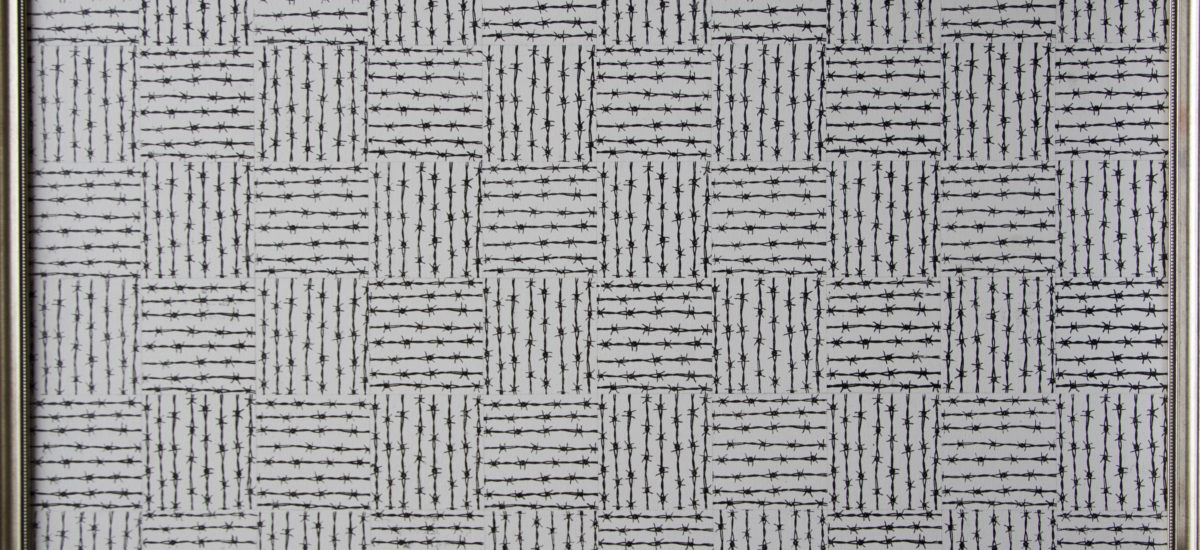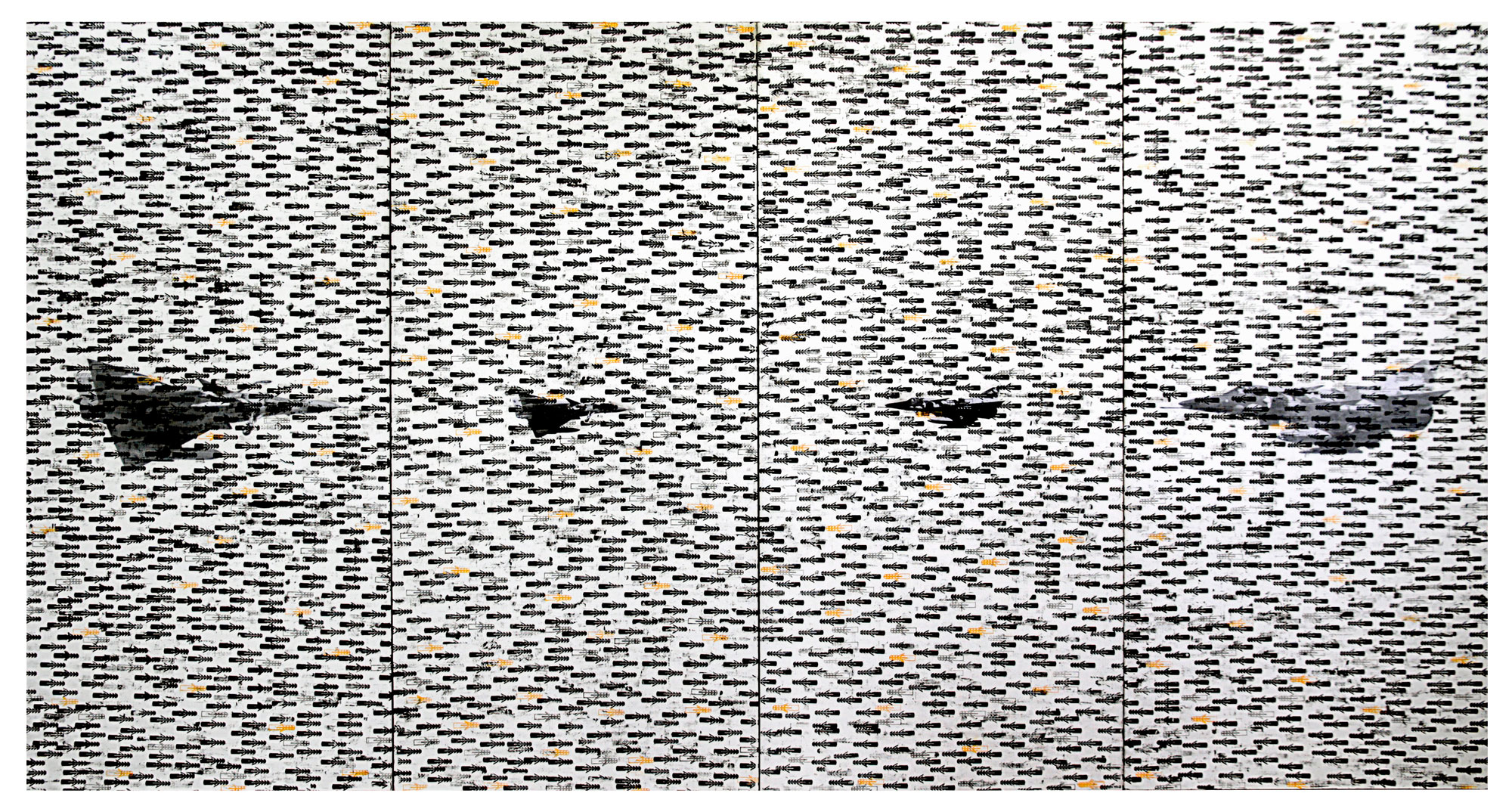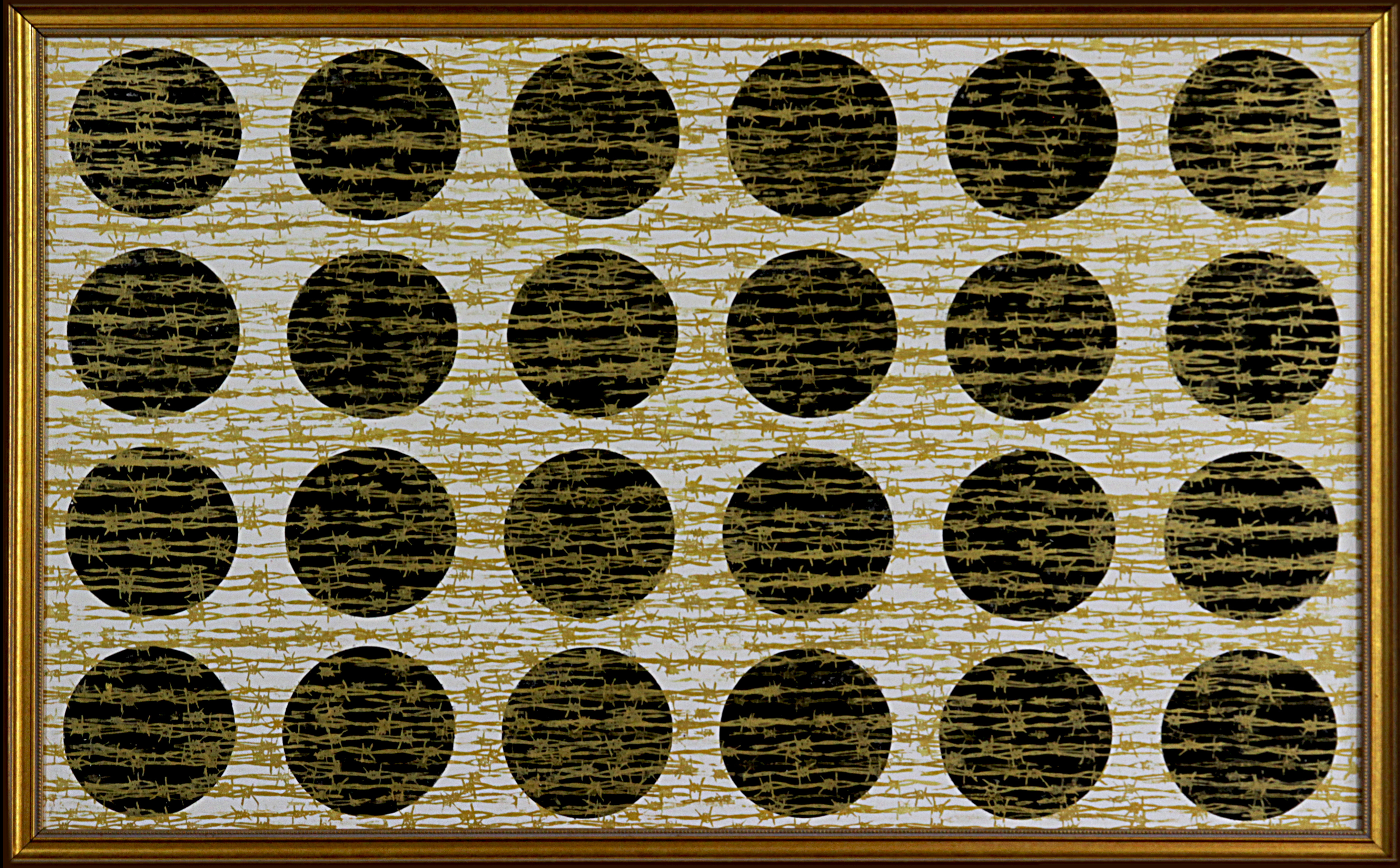Art by Koralegadara Pushpakumara. Barbed Wire (xiii) 2012 Screen Print, Acylic on Canvas 110×67.5 cm.
He can see through the threatening spikes of barbed wire. He is anguished recalling the nightmarish experiences of violent outbreaks. But he was hardly hopeless eyewitness. He allows his works to narrate such experiences, and while doing so he adds aesthetic idioms to experiences of past. Koralegadara Pushpakumara takes us on imaginary flights mixing romance and reality. His truth claims in the artworks result into an art of sarcasm. As fondly called by friends, Pushpe has endeavored to conjure an image of Sri Lanka neatly blending his personal experiences and public history. This is not the Lanka that tourist guidebooks describe; nor do state officials discuss about it. Pushpe’s Lanka has come to India in a show of his select works, titled Dissonant Images ongoing at the gallery Exhibit 320 in New Delhi. Like some of his compatriots, Pushpe’s Lanka invites art-lovers to reconfigure Sri Lanka. This is an aesthetic imagination of Lanka at the cusp of romance and reality. Suffice to say, it underpins the experiences of the artist who was an active eyewitness of insurgency, political violence, and civil war in Sri Lanka. The curious combination of symbols in his works present experiential accounts loaded with sarcasm.
Excavation (school uniform, burnt tyre) 2004 Mixed media 210 x 54 cm.
I Saw Them Die and Disappear: Eyewitness Artist
Koralegadara Pushpakumara hails from a family of carpenters with ambitious artistic inclinations toward woodwork. The famous woodcarvings of the Gadaladeniya and Ambekka temples in Kandy were the source of inspiration for the growing Pushpe. He aspired to continue with his calling and experiment with woodcarving, but could not stay away from the political revolution, which was in the offing. As a growing child, he had encountered caste discrimination that his friends from the lower caste groups had experienced. With a sense of Buddhist equality at the top of his mind, he was dismayed about the divide between Govigama(the land-owning upper caste group among Sinhalas) and Rodi (a lower caste group, which technically exists outside of the Sinhala caste system and were traditionally confined to jobs of low esteem).Like many Sinhala youth, he inched towards the transformative dream of the political left and it’s most concerted manifestation popularly known as JVP (Janatha Vimukthi Peramuna or people’s liberation front). Most of the youths inclined to the JVP attended their political indoctrination lectures in desolate locations around Peradeniya and Kandy.
Janatha Vimukthi Peramuna was formed in 1960s including initially as a Beijing-leaning Marxist outfit. It has a history of a twofold critical periods. One was the armed struggle against the ruling government in 1971, and the other was the more violent uprising during 1987-1989.Making an appeal to the masses justifying the struggle, the JVP’s leader of the time, Rohana Wijeweera asserted,
“When the government violates the rights of the people, insurrection is for them the most sacred of rights, the imperative of duties. The only remedy against authorized force is to oppose it by force” (Quoted by R. Gunaratna in Sri Lanka: A Lost Revolution, published by Institution of Fundamental Studies, 1990, p. 120).
The 1971 uprising against the Bandaranaike government attracted attention worldwide. The crackdown of the uprising claimed the lives of more than ten thousand youths in Sri Lanka. Wijeweera was arrested and imprisoned in Jaffna, among other places. This bitter defeat led to the vengeful JVP latter insurgency that lasted from1987-1989. In this spell, armed JVP cadres attacked the Sri Lankan government, state machineries, as well as the people who opposed the violent strategies of the JVP and many ordinary people who were simply in the wrong place at the wrong time. Moreover, certain units of the JVP aggressively fought against the Indian Peace Keeping Force occupying northern and eastern Sri Lanka at time and in general successfully mobilized an anti-India sentiment preventing Lankan folks from consuming Indian goods. However, the result of this uprising too included massive casualty of the innocent people, JVP cadres, government personnel, and the life of the JVP leader, Wijeweera too.
It was in this situation of an exceedingly decimated JVP that as an active cadre Pushpkumara experienced a threat to his own life, and fled to Ampara, located in the Eastern Province of Sri Lanka. He recalls that he used to have a cyanide pill in a locket hanging from his neck those days, so as he could commit suicide if he was arrested. But he could not escape arrest. In his own words, “in 1989, I was a final year student at school, a 21 year old activist of the student movement attached to the JVP that rose against the Sri Lankan government. Then the government crack down on the JVP began. Being an active JVPer, in fear of persecution, I fled to Ampara, where another war against the Tamils was going on. In this border village, I was captured, detained and tortured. Finally, miraculously, I was released for which the exact reason is still not fully clear to me.”
He was a fugitive still performing his artistic woodwork at his brother’s workshop in Ampara and was sought after among local householders who thought his works provided a good and affordable decorative frills for their living rooms. He had by this time realized the consequences of the uprising, violent loss of lives rather than the promised structural transformation. He witnessed the elaborate mechanism of killing employed by both the JVP and the Sri Lankan armed forces and police. He watched in helplessness the notorious necklace, the circle of burning tyres to asphyxiate and simply burn rebels and suspects. Pushpe recalls, “many thousands disappeared and were killed both in the war and in the uprising”. He adds further, “After 15 years, being an ex-JVPer and an active artist, I joined an institute in Colombo to do a post graduate diploma in archeology. The assignment was about dating dead bodies. I couldn’t escape the flashback. And my question was could anyone find and date dead bodies of contemporary youth who had disappeared, and the people who were massacred in the war in North. They will be under burnt tires with engine oil mixed decaying, charred clothes. You wouldn’t find the typical succession of insects, other creatures and decaying patterns – you would need a different theory to explain and date them”.
Wall Plug (16) 2013. Mixed media on canvas 190.5 x 360 cm.
Inevitableness of Politics in Sri Lanka
He returned to Colombo and obtained a formal art education from the Institute of Aesthetic Studies, University of Kelaniya in 1997.Pushpe became one of the early artists in the contemporary visual art in Sri Lanka that has been discussed as “1990s trend” by the eminent art historian and doyen artist Jagath Weerasinghe.
Along with Jagath, Anoli Perera and others contributed to this trend, creating a new paradigm of artistic practices under the institution named Theertha Artists’ Collective based in Colombo. A vivid turn to the political underpinned the visual arts at Theertha. And the political undercurrents and appeals of these artworks subsumed the individual self, socio-cultural traditions, and politico-public encounters of violence. Thus, in Jagath’s analysis, “Pushpe is quite conscious of the sociocultural underpinnings that forms the basis of his existence as a painter”. This is very evident in some of the most famous works of Pushpe that have been featured in various exhibitions including the one ongoing at the gallery, Exhibit 320 in New Delhi. Pushpe articulates his motif and objectives, saying, “the patterns and motives in my work connects and resonates patterns and motives seen in traditional Sri Lankan art. My attempt is to build an idea about the establishing post-war cultural patterns”.
For example, his series titled ‘Goodwill Hardware’ and ‘Barbed Wire’ stand testimonial to Pushpe’s quest for culture in the times of civil war and its aftermath. He fuses the sublime and the bizarre, the innocuous and the injurious, the colorful and the banal to engender a sense of sarcasm. Anoli Perera, another towering artist from the “1990s trend” noted, “the glossy decorative picture frames around these canvases depicts the violence which has been contradictorily elevated into the level of fervor. It also talks about the violence and cruelty that have been reinterpreted and simplified as unavoidable circumstances by society that is in a grandiose fervor. Pushpe’s work becomes important particularly in the post-war situation where already, the society has started to forget the recent violent past, and artists have begun to move away from political and interventionist themes”.
In the artistic quest for culture, Pushpe combines the traditional and the contemporary. The motif of knots borrowed from the woodcarvings in the Ambekka Devalaya (shrine) in Kandy surfaces in his work, ‘Barbed Wire.’ The knotty barbs in a frame of normal unsettle the usual grammar of viewership and art-appreciation. Besides, Pushpe scatters fine dots in most of his works to symbolize his lineage to the vocation of woodcarving by professional traditional carpenters in Sri Lanka. And he does not shy away from adopting mundane symbols of violence either. His work titled ‘Excavation’ puts burnt tyres in the center of the canvas to deliver a comment on the consequences of extreme political violence. He expresses a sense of disarming sarcasm in his series titled, ‘Goodwill Hardware’ in which plastic-covered barbed wire appear in intriguing patterns. And, to top it all, he toys with another symbolism in his work titled, ‘Wall Plug’with strokes of his brush creating a colorful pond with the famous Lankan flower Niyangala (Gloriosa Superba/ Glory Lily/Poison Flame). The beautiful flowers have poisonous roots, which Pushpe had seen being consumed by the distressed in the Lankan countryside to commit suicide. Most of the other works by Pushpe persist with the juxtapositions of opposites, mixing of the innocent and the violent. One could perhaps end up hearing the sardonic snigger of the artist while browsing through Pushpe’s works.
Barbed Wire (xii) 2012 Screen Print, Acylic on Canvas 110×67.5 cm.
In Nutshell
Through systematic research on the artworks of“1990s trend”, Sasanka Perera presented an anthropological interpretation for this genre of work in his book, Violence and Burden of Memory: Remembrance and Erasure in Sinhala Consciousness. He suggested that the artists representing this trend employ their personal and public memory to offer a distinct sense of recent political and social history in contemporary Sri Lanka. Pushpe is squarely in the midst of this trend and the politics it represents. Among many other artists following this trend, Pushpe creates his own idea of Sri Lanka that collapses history and biography, disturbing the fixed notions of history, politics and art.
The author teaches sociology at the Department of Sociology, South Asian University, New Delhi and has research interests in art and performance in Sri Lanka, India and Bangladesh.




